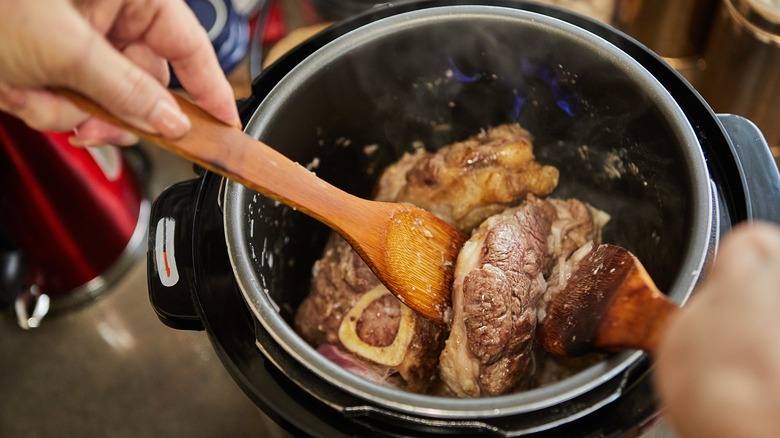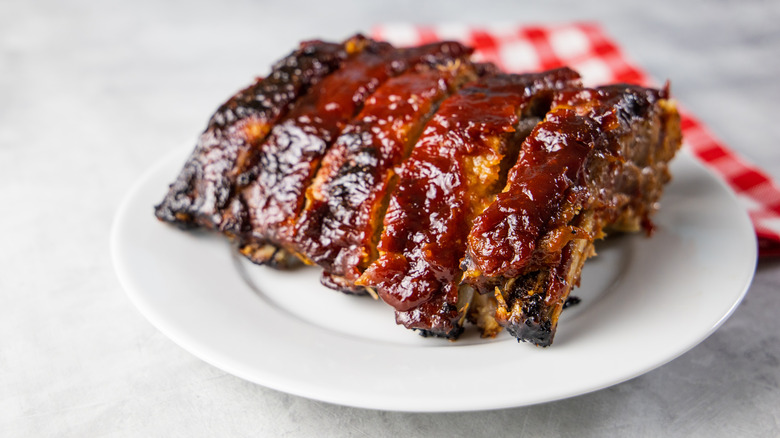What To Know Before Cooking Meat In A Pressure Cooker
When deployed correctly, a pressure cooker can be one of the most powerful tools in a cook's arsenal. Dishes that would typically take most of the day to cook can be turned out in an hour or less, particularly slow-cooked meats like pot roast or pulled pork. Once you've experienced this level of convenience, it can be tempting to whip the pressure cooker out for any meaty dish, but this technology isn't a catch-all solution to mealtime. Pressure cookers only work for dishes with a high moisture level, such as braises and stews. They cannot produce a crispy chicken skin or charred steak crust. That's because anytime you make something in a pressure cooker, you need to add liquid; these devices cannot function without it.
The reason pressure cookers are able to cook food so quickly is that they can reach higher temperatures than a regular pot on the stove. We're taught that water boils at 212 F (110 C), but that's only true when you're at atmospheric pressure. A pressure cooker can generate twice as much pressure as Earth's atmosphere, raising water's boiling point to 250 F (121 C). This means you can cook food at a higher temperature without burning it. Plus, since the cooker traps moisture, your meat won't dry out. However, neither can happen without some liquid in the cooker, so you need to pick the right meats and recipes.
Pressure cooking doesn't work with every kind of meat
Pressure cookers are highly effective at transforming tough, gristly cuts of meat into exquisitely tender meals. Cuts taken from around an animal's legs, such as beef chuck and pork shoulder, are chewy because they contain connective tissue like tendons and ligaments. Most of the connective tissue in animals is made up of the protein collagen, which is very tough. However, if you properly cook collagen, it turns into moist gelatin. This usually takes a long time over low heat, but a pressure cooker can significantly expedite this process. When you have a piece of meat with a lot of gristle on it, your pressure cooker will be your best friend. Better still, these cuts are often the least expensive.
Other meats should not be made in a pressure cooker; interestingly, these are usually the more expensive cuts. Generally speaking, no type of steak is going to respond well to pressure cooking. First, they are typically quite tender already due to their intramuscular fat (marbling), and pressure cooking will actually take longer than cooking a steak on the grill. Any meat you would typically grill or pan-sear probably isn't a good choice for pressure cooking. This also applies to extremely lean meats with no fat, skin, or bones, such as pork tenderloin, beef sirloin, and boneless, skinless chicken breast. Because these cuts don't have fat or connective tissue to break down, they can turn out dry.
Use a broiler to put a last-minute sear on pressure-cooked meats
One of the downsides of using a pressure cooker is that you cannot get a caramelized finish on your meat. Think of the crispy skin of a roast chicken or the dark crust on a rack of smoked ribs. Many pressure cooker recipes call for you to sear the meat in the cooker using the sauté function before adding liquid and sealing the lid. Searing the meat before pressure, cooking helps to create some of that rich, caramelized flavor we love. It will also leave browned bits on the bottom of the cooker (known as fond) that are packed with umami. You can use your cooking liquid to deglaze the pot and transfer that flavor throughout the dish. However, once you add your seared meat to the liquid and pressure cook it, that crispy exterior will soften, robbing you of the textural experience. Fortunately, there's a way around this.
Let's say you make a rack of ribs in your pressure cooker. Overall, this is a great idea because the pressure cooker will give the ribs that perfect, fall-off-the-bone texture. The only problem is that they won't have the nice charred crust you get from a barbecue. To get the best of both worlds, start by pressure cooking those ribs, then put them under a broiler for a few minutes until they form a crust. You can apply this technique to any pressure-cooked meat that needs a little sear for perfection.


